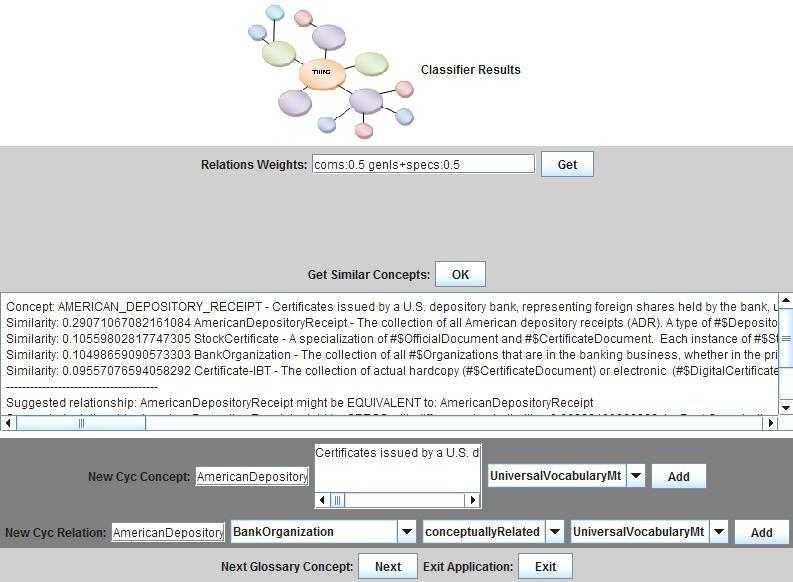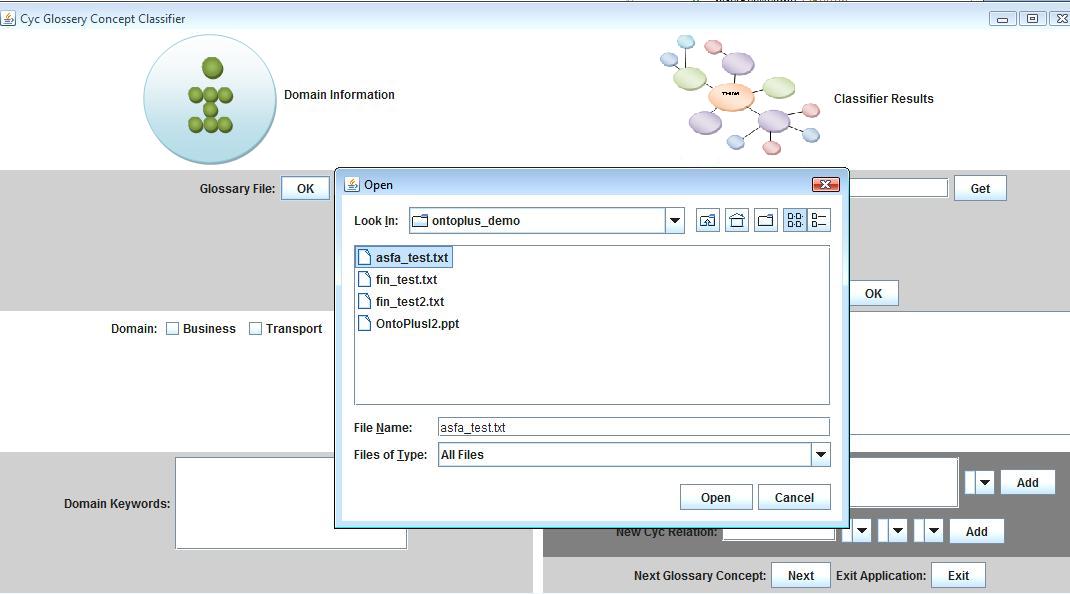In order to demonstrate the OntoPlus methodology in practice, as a part of this research, we have developed a software prototype.
The software (size: 4.85 MB) is implemented in Java programming language. The software architecture includes several components, such as user interface component, preprocessing component, ontology subset extraction component and similarity calculation component. The goal of the user interface component is the communication with the user – specification of the domain relevant information (domain glossary; domain keywords; content, structure and co-occurrence weights etc.) by the user and displaying the results (a list of glossary terms with related ontology concepts and potential relationships) to the user. The preprocessing component has a number of functions for stemming, tokenization, stop words removal etc. The goal of ontology subset extraction is to obtain the relevant domain subset of the Cyc ontology based on domain glossary and domain keywords – relevant Cyc concepts with comments. Finally, the similarity calculation component contains functions for similarity calculation between existing and candidate ontology concepts.
The software works with the Cyc Knowledge Base and glossary files in textual formats.
User actions are the following:
1. Choose glossary file.
2. Select domain from predefined domains (Transport, Business, Aquaculture) or enter domain keywords:
3. Enter content (coms), structure (genls+specs), co-occurrence (co-occurrence) weights and deviation (dev) as following: coms:w1 genls+specs:w2 co-occurrence:w3 dev:0.3
Please, note that w1+w2+w3=1.0, 0>dev <1.0  4. Get similar concepts and relations
4. Get similar concepts and relations 
For each glossary term, in the result window, the number of related Cyc concepts with comments are displayed in the form of ranked list - from more related to less related. Also, the potential relationships between glossary concepts and Cyc concepts are displayed below.
In the line New Cyc Concept it is possible to add new glossary concept to Cyc with concept name obtained from glossary term name, comment obtained from glossary description. User can select the microtheory.
In the line New Cyc Relation it is possible to specify a relation between glossary term (let's say, previously created Cyc concept) and other Cyc concepts.
Following that, the user can move to the Next glossary term or Exit the program.
In order to demonstrate the OntoPlus methodology in practice, as a part of this research, we have developed a software prototype.
The software (size: 4.85 MB) is implemented in Java programming language. The software architecture includes several components, such as user interface component, preprocessing component, ontology subset extraction component and similarity calculation component. The goal of the user interface component is the communication with the user – specification of the domain relevant information (domain glossary; domain keywords; content, structure and co-occurrence weights etc.) by the user and displaying the results (a list of glossary terms with related ontology concepts and potential relationships) to the user. The preprocessing component has a number of functions for stemming, tokenization, stop words removal etc. The goal of ontology subset extraction is to obtain the relevant domain subset of the Cyc ontology based on domain glossary and domain keywords – relevant Cyc concepts with comments. Finally, the similarity calculation component contains functions for similarity calculation between existing and candidate ontology concepts.
The software works with the Cyc Knowledge Base and glossary files in textual formats.
User actions are the following:
1. Choose glossary file.
2. Select domain from predefined domains (Transport, Business, Aquaculture) or enter domain keywords:
3. Enter content (coms), structure (genls+specs), co-occurrence (co-occurrence) weights and deviation (dev) as following: coms:w1 genls+specs:w2 co-occurrence:w3 dev:0.3
Please, note that w1+w2+w3=1.0, 0>dev <1.0  4. Get similar concepts and relations
4. Get similar concepts and relations 
For each glossary term, in the result window, the number of related Cyc concepts with comments are displayed in the form of ranked list - from more related to less related. Also, the potential relationships between glossary concepts and Cyc concepts are displayed below.
In the line New Cyc Concept it is possible to add new glossary concept to Cyc with concept name obtained from glossary term name, comment obtained from glossary description. User can select the microtheory.
In the line New Cyc Relation it is possible to specify a relation between glossary term (let's say, previously created Cyc concept) and other Cyc concepts.
Following that, the user can move to the Next glossary term or Exit the program.
In order to demonstrate the OntoPlus methodology in practice, as a part of this research, we have developed a software prototype.
The software (size: 4.85 MB) is implemented in Java programming language. The software architecture includes several components, such as user interface component, preprocessing component, ontology subset extraction component and similarity calculation component. The goal of the user interface component is the communication with the user – specification of the domain relevant information (domain glossary; domain keywords; content, structure and co-occurrence weights etc.) by the user and displaying the results (a list of glossary terms with related ontology concepts and potential relationships) to the user. The preprocessing component has a number of functions for stemming, tokenization, stop words removal etc. The goal of ontology subset extraction is to obtain the relevant domain subset of the Cyc ontology based on domain glossary and domain keywords – relevant Cyc concepts with comments. Finally, the similarity calculation component contains functions for similarity calculation between existing and candidate ontology concepts.
The software works with the Cyc Knowledge Base and glossary files in textual formats.
User actions are the following:
1. Choose glossary file.
2. Select domain from predefined domains (Transport, Business, Aquaculture) or enter domain keywords:
3. Enter content (coms), structure (genls+specs), co-occurrence (co-occurrence) weights and deviation (dev) as following: coms:w1 genls+specs:w2 co-occurrence:w3 dev:0.3
Please, note that w1+w2+w3=1.0, 0>dev <1.0  4. Get similar concepts and relations
4. Get similar concepts and relations 
For each glossary term, in the result window, the number of related Cyc concepts with comments are displayed in the form of ranked list - from more related to less related. Also, the potential relationships between glossary concepts and Cyc concepts are displayed below.
In the line New Cyc Concept it is possible to add new glossary concept to Cyc with concept name obtained from glossary term name, comment obtained from glossary description. User can select the microtheory.
In the line New Cyc Relation it is possible to specify a relation between glossary term (let's say, previously created Cyc concept) and other Cyc concepts.
Following that, the user can move to the Next glossary term or Exit the program.

